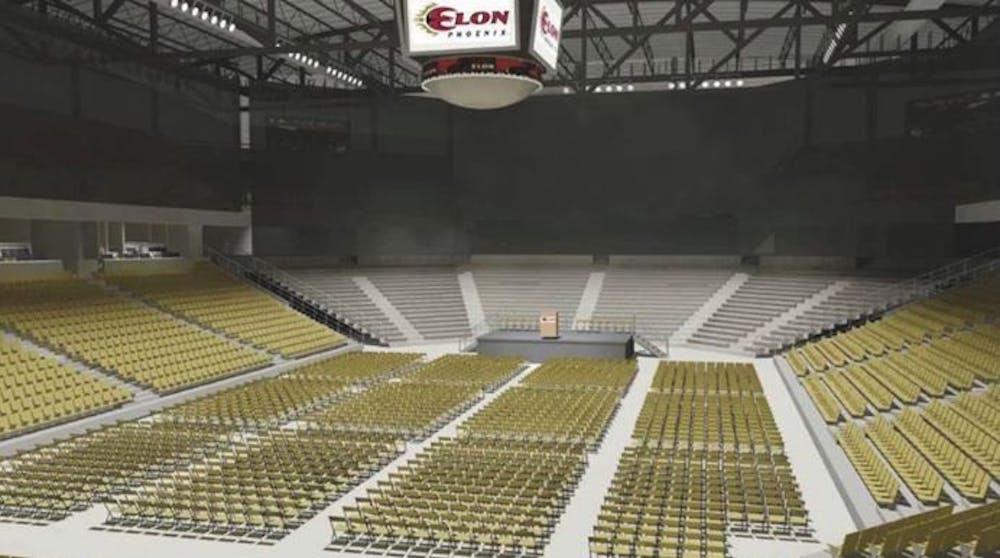Bigger and better does not the best campus make — despite what Elon University would have you think.
The latest in a series of dramatic transformations, plans for a new “Convocation Center,” a 5,000-seat stadium and gathering place, have been backed already by an $8 million donation. Heralded by Elon as a much-needed space for campus-wide conversations, the multi-use facility aims also to push the school’s struggling athletics to a place of prominence in its transition to the Colonial Athletic Association (CAA).
There is a much better use for that much money, but the sell is a much harder one. It requires focusing not on the present, not on the near future, but rather on what’s quite a ways down the road.
That $8 million should be invested in Elon’s endowment.
Part of the largest single donation in the university’s history — $12 million total — the targeted gift this school year by Elon parents Dwight and Martha Schar was heralded as a “historic investment in Elon’s future.”
The lack of sustainable financial support for that future is troubling.
To start, Elon is a tuition-dependent institution, meaning it relies almost exclusively on new students each year to pay the university’s day-to-day bills. That source looks to be reliable — so far, the school has executed its “slow growth” model quite well.
Endowments are targeted gifts, yes, but they become a reflection of the university’s priorities. The Schars didn’t dream up the Center. Elon did. They generously supported.
This reliance on tuition comes at the expense of financial aid. Take a trio of Elon’s self-identified peer and aspirant institutions: Davidson College, the University of Richmond and Wake Forest University. Now, take recent valuations of their respective endowments: $649 million, $2.02 billion and $1.06 billion.
Take Elon’s endowment: $191 million. To be fair, it has more than tripled since its 2005 valuation of $61.275 million. That’s not pocket change. That means something.
But shoring up the university’s financial security has long taken a backseat to cushioning its amenities. The “country-club effect” is an over-simplification, but not much of one. Sorry, High Point University, but we’re you in a book-smart sheep’s clothing.
Despite the buzz around Elon’s academic rise from a party school to a force to be reckoned with, the numbers don’t quite match up. Over the last decade, applications have swelled, but so has the acceptance rate.
At a time when most acceptance rates are the lowest ever — the result of aggressive marketing tactics from college admissions offices — Elon’s has gone in the opposite direction. It’s up a staggering 13 percentage points from 2005’s rate, to 54 percent this year.
We’re attracting more students. We’re not attracting better ones. And we’re attracting a lot of carbon copies of each other.
It all circles back to funding. The whitewashed campus — 82 percent so — is comfortable for students who know no different. It captivates prospective students for the wrong reasons. I know it — I was one.
Despite what I tell almost everyone, I didn’t choose Elon for its academic rigor or renowned communications program. I chose Elon because the grass was flawless and the people were beautiful, because it seemed to me the kind of place where nothing could go wrong.
Shallow? Yes. Shortsighted? Absolutely. But at least now I can admit it. And I know I’m not the only one.
For now, all the talk of improving intellectual climate and increasing the caliber of academics is just that — talk. There is no question that Elon has grown by academic leaps and bounds since President Leo Lambert took over and led the school into the national spotlight. He has provided the kind of vision and leadership that has taken Elon from a small regional college to a university with a national name to match.
But on what are we staking such progress? Is it architecture alone?
To be sure, the Convocation Center will work wonders for recruiting, a shimmering shrine to the basketball and volleyball teams. To be sure, the athletes — even the struggling men’s basketball team — deserve a better place to play than the half-century-old Alumni Gym. (That said, I’m not sold on doubling the capacity for a team that sells out only a handful of games each season.)
But, there’s more at stake here, and that’s a focus on the flashy. Elon has staked its reputation more on well-watered lawns than on those who walk them. From the hotel-like Global Neighborhood to the new admissions center of palatial proportions, the university has placed a premium on eye candy.
A Convocation Center would be nice, but it’s not what should matter most to this university at this time. If endowed with a standard 4.5 percent return, that $8 million would generate $360,000 in interest each year. That’s real money to make Elon more affordable, real money that says something.
As long as Elon remains a tuition-dependent university, what we say will never be what we mean. Unless we can see beyond buildings, we’ll lag always a step behind.
The true worth of a college education lies in the maturation of the diploma. Making sustainable funding the university’s top priority will, in time, deliver the best return on the investment of its students.


